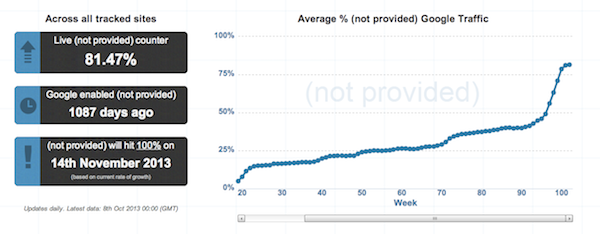Two years ago, Google began restricting information about the keywords searchers used to find a site when they were signed into their Google account.
Throughout this period, as different browsers have added encrypted search, the number of “Not Provided” encrypted search terms has gradually increased.

Now, thanks to a recent change by Google, ALL searches will be encrypted regardless of whether or not the user is signed in. This removes specific SEO search query data from Google Analytics. What are the implications of this? For most sites, counts of specific search terms in Analytics are now ambiguous and highly misleading.
For example, a company selling used farm equipment wants to know what keywords are driving people to its site. If the company examines analytics to see which keywords people are searching in Google to access its site, the company will notice the number one search keyword for a site is almost always “Not Provided.”
Challenges for SEO
This means that it has become more challenging to analyze the effectiveness of SEO. When “Not Provided” was 25-33% of the results obtained, it wasn’t much of an issue because companies could extrapolate based on the other popular search terms. However, now that “Not Provided” has become as prevalent as it has, they can’t get the same level of feedback.
This is especially a concern if companies are paying an agency to improve SEO, because now – through no fault of their own – they are less accountable. So, what are some alternative tools and resources you can use to evaluate your SEO effectiveness? Here are a few to explore and consider implementing:
- Use Google Webmaster Tools
In order to make your data available in Google Analytics, you have to link your Analytics account with Google Webmaster Tools. This gives you the average position for a search term and allows you to see search impression against click classified by query.z - Use Google AdWords Paid and Organic Report
In August 2013, Google announced this exciting new feature on its inside AdWords blog – again you have to be connected to Google Webmaster Tools. It’s excellent in that it displays natural and paid results side by side and allows you to look at performance in terms of click-through rates – CTR – when ads are present and when they aren’t.In addition, you aren’t required to have a Google AdWords account, and this data appears to be more accurate than Webmaster Tools, which rounds data for organic search queries to the nearest hundred. Unfortunately, it’s not in Google Analytics, but it’s possible that could happen one day. - Design a Filter to Locate Where “Not Provided” Traffic is Entering Your Site
With this approach, the relevant landing page URL is added to the keyword, so in a relative way, you can provide feedback as to which pages are and are not prompting natural visits through search. It can be a little difficult to set up – it rewrites the “Not Provided” data upon being added to Google Analytics when the tag fires – so it’s recommended only advanced users attempt setting it up. - Use Tools to Check Rank
Google has discouraged these tools over the years, but the recent changes they’ve implemented make rank-checking tools even more of an enticing idea. Checking rank can give you insight as to which terms are competitive, and you can take that information and use it for the benefit of your website.
It’s evident that “Not Provided” has had a significant impact on affiliate marketers. However, with all of the tools and resources available to circumvent the issue, it shouldn’t be cause for alarm. Take advantage of the suggestions listed above to get an accurate feel for your SEO effectiveness and bring your A-game to all of your marketing endeavors.

Leave a Reply